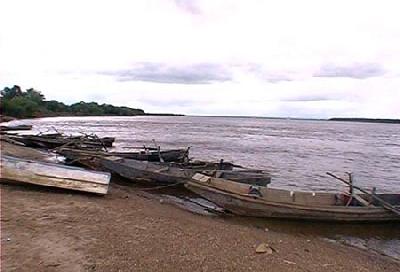Heilongjiang River
 The Heilongjiang River, the Sino-Russian boundary river, runs across the northern part of north China. Its headstream includes the northern source and the southern source. The northern source Shilka River originates from the eastern foothills of the Mount Kent in the Outer Mongolia, and the southern source Argun River originates from the western slope of China′s Great Hinggan Mountains. After the convergence of the southern source and the northern source at the Xiluoguhe Village, Mohe City, China, the river is called as the Heilongjiang River that runs eastwardly and finally empties into the Sea of Okhotsk. The Heilongjiang River flows across China, Russia and the Outer Mongolia. Its entire length is 4,370 kilometers, the 11th largest river in the world. Its drainage area is up to 1,843,000 square kilometers, ranking the 10th largest in the world. The drainage area within China accounts for 48% of the total drainage area.
The Heilongjiang River, the Sino-Russian boundary river, runs across the northern part of north China. Its headstream includes the northern source and the southern source. The northern source Shilka River originates from the eastern foothills of the Mount Kent in the Outer Mongolia, and the southern source Argun River originates from the western slope of China′s Great Hinggan Mountains. After the convergence of the southern source and the northern source at the Xiluoguhe Village, Mohe City, China, the river is called as the Heilongjiang River that runs eastwardly and finally empties into the Sea of Okhotsk. The Heilongjiang River flows across China, Russia and the Outer Mongolia. Its entire length is 4,370 kilometers, the 11th largest river in the world. Its drainage area is up to 1,843,000 square kilometers, ranking the 10th largest in the world. The drainage area within China accounts for 48% of the total drainage area.
The Heilongjiang River was known as the Yushui, Wanshui and Heishui in ancient China. The forests are luxuriant and the aquatic grasses are verdant wherever the Heilongjiang River flows across. The rich black humus in the soil is carried into the river by the surface water and the river water therefore becomes livid. The Manchu people living in the Heilongjiang River Valley call the river Sahalianwula, the Sahalian means the black color, and the Wula means the river. The name of the Heilongjiang River (river in the shape of a black dragon) was thus formed. Therefore, it is lively and visual to name the slightly black river that looks like a black swimming dragon as the Heilongjiang River.
The Heilongjiang River has total 200 more tributaries in which the large ones include the Songari River, the Wusuli River, the Zeya River and the Bulieya River.
Songari River is the largest tributary of the Heilongjiang River, with a total length of 1,657 kilometers and a drainage area of over 550,000 square kilometers. Its source, the Heaven Lake, has beautiful scene and has been an important tourist resort all through the ages. The primitive forests can be seen everywhere in the Songari River valley, the forest region with largest area in China. The soil in the Songari River valley is fertile, and it abounds in soybean, maize, broomcorn, wheat, flax, cotton, apple, sugar beet and other crops. It is also a large fishing water of freshwater. The main products include the carp, crucian, Huso dauricus and other fish. In addition, local inhabitants use ice to sculpt various ice lanterns, which are the fine folk artworks with special characteristics.
artworks with special characteristics.
The total length of the Wusuli River is 905 kilometers, with a drainage area of nearly 187,000 square kilometers. The soil of the Wusuli River is fertile, primitive forests can be seen everywhere, a great deal of minerals are held in the area, and it abounds in soybean and broomcorn. In addition, the aquatic resources are very rich, including the special local products of salmon, huso sturgeon, bighead fish, sturgeon and dongzhu (a kind of pearl), etc.
Along with the frequent commercial intercourses with Russia in recent years, China successively opened 7 ports to carry out commercial trade with Russia. The freight of 1990 alone was up to 400,000 tons, so these ports can bring significant economic benefits to the two countries every year.
Source: http://www.chinaculture.org